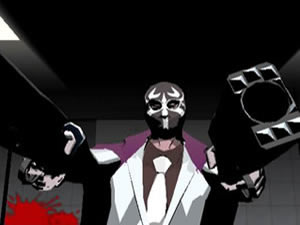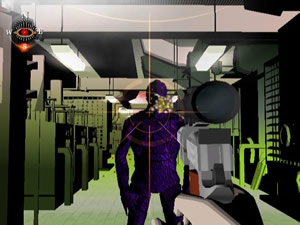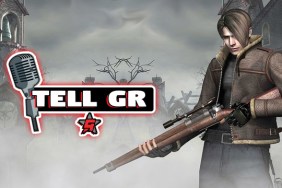Personality disorder.
We are connoisseurs of weirdness. There’s weird for the sake of being weird, the high-school goth chick, vampire-lesbian weird, which we hate. There’s weird for the sake of amusement, the Weird Al goofball Hawaiian-shirt-with-a-parrot-on-my-shoulder weird, which we tolerate only because we like the accordion. Then there’s weird for the sake of artistic integrity. Katamari Damacy was that kind of weird, as are the films of David Lynch and the music of David Bowie. It’s unfiltered, raw weird. We like that weird a lot, only in part because it makes us look smart and hip.
Capcom’s Killer 7 is all of these weirds crammed into one, a frighteningly erratic head trip that will leave you gasping for air and grasping at mental straws. It’s a brazenly mature and flat-out kooky melding of a distinct art style and a creepy plot, equal parts good weird, tolerable weird, and bad weird merged into a psychotic whole.
It’s just too bad that it also happens to suck. Kinda. In a weird way, no less.
Spanning two discs, Killer 7‘s insane story is set in an alternate reality. The world decides to rid itself of nuclear weapons, embarking on a journey towards unequivocal peace that culminates in the expulsion and subsequent explosion of the planet’s stockade of missiles. But just as we grow comfy in our newfound rainbow land, a terrorist organization called the Heaven Smile, comprised of invisible, monstrous, cackling humanoids, disrupts a U.N. summit and begins to wreak random havoc. In response, the world calls in the Killer 7, a group of legendary assassins, to take down the menace and restore order.
Or at least that’s how they describe it in the manual. The bulk of the “plot” actually has to do with you playing as the seven personalities of Harmon Smith, a nutty old man bound to a wheelchair who wields a massive gun, talks to dead people and drools on himself while being waited on and/or sexually abused by his loyal maid and/or whorish babysitter, Samantha.
Told you it was weird.
And it only gets weirder. You progress through the linear if often incoherent story playing as the various members of the crew (or Harmon’s cortex, whichever theory you prefer to follow), battling the Heaven Smile, chatting up wacko NPCs and solving puzzles. While this seems pretty standard, it’s not even close.
For starters, you don’t actually move “around.” Instead, you press the A button to make your character proceed down what’s essentially a fixed rail as windows pop up to indicate that you can either branch off down another path (like a new hallway), interact with an object or talk to an NPC. Pressing B turns you around, and that’s it. It’s not as bad as it sounds, since unlike MYST (after which parts of Killer 7 are clearly modeled), you actually watch your character move in real time. Though you can’t freely explore the environments, most linear games put up invisible walls to block off the environment anyway. This is just a far less subtle version of that.
 And it’s only the first of many obtuse design decisions. As you plow through each level holding down A, you’ll occasionally hear an eerie laugh. This is your cue that some Human Smiles are in the area, so you stop moving, press R to bring up a first-person gun view, and press L to scan the scene and reveal the sinister enemies shambling towards you. The game then becomes a shooting gallery as you attempt to kill all the bad guys before they reach you and explode. The seven assassins carry marginally different weapons, but whether you’re using Kaede Smith’s sniper gun or Mask de Smith’s dual grenade launchers, you just aim and fire at the freakish things making a beeline for your crazy ass.
And it’s only the first of many obtuse design decisions. As you plow through each level holding down A, you’ll occasionally hear an eerie laugh. This is your cue that some Human Smiles are in the area, so you stop moving, press R to bring up a first-person gun view, and press L to scan the scene and reveal the sinister enemies shambling towards you. The game then becomes a shooting gallery as you attempt to kill all the bad guys before they reach you and explode. The seven assassins carry marginally different weapons, but whether you’re using Kaede Smith’s sniper gun or Mask de Smith’s dual grenade launchers, you just aim and fire at the freakish things making a beeline for your crazy ass.
This clunky shooting system has fatal gameplay ramifications. You cannot move and fire at the same time, a snafu that will undoubtedly prove frustrating to action gamers. Meanwhile, adventure fans will have a hard time getting used to the awkward three-step process of switching to first-person, scanning the scene, then shooting like mad. Often enemies will spawn in a few feet away, making you frantically fire off some shots to slow them down only to die as you reload, despite having limitless rounds. The whole ordeal is just that – an ordeal – which isn’t what you want out of the simple act of killing the bad guys. Doing so gives you blood, which is used to upgrade four stats for each character, but upgrading doesn’t mask the gratingly repetitive action.
Although compared to the puzzles, the gunplay feels like Halo. Nearly every level forces you to find an “odd-shaped engraving” (ie. a “key”) to proceed. Locating such wondrous items is accomplished through solving some of the lamest brainteasers since someone first asked why a chicken would dare cross a road. For example, you’ll have to light several candles in a certain order. If you’re stumped, just check the bottom of each candle and the “1, 2, 3, 4, 5” numbering scheme might lend a tip or five. Often they solve themselves, such as when you meet up with Travis, one of your many ex-living informants, and he explains that “the word on my shirt is the password.” How cryptic…until not ten minutes later you’re presented with a locked door requiring a password. No, the word on his shirt is not “Stupid.” The puzzles admittedly get a little better later on in the game, but it’s hard to care when most of them are so uninspired.
 Fleshing out the experience is the use of the seven assassins. There’s a modicum of strategy at play thanks to their different abilities, but again, the solutions are spelled out for you. Coyote Smith can open padlocks, so it’s pretty obvious that when you come across a padlock, you switch to him. We understand that Mask de Smith, the pro wrestler (weird, again, sigh), can move large obstacles, yet when you run up to something big, the game drops subtle hints like “use the wrestler.” Even the in-game map is for morons, as it literally features icons detailing the character needed to progress through a section or where to find that one missing key. I mean, odd-shaped engraving.
Fleshing out the experience is the use of the seven assassins. There’s a modicum of strategy at play thanks to their different abilities, but again, the solutions are spelled out for you. Coyote Smith can open padlocks, so it’s pretty obvious that when you come across a padlock, you switch to him. We understand that Mask de Smith, the pro wrestler (weird, again, sigh), can move large obstacles, yet when you run up to something big, the game drops subtle hints like “use the wrestler.” Even the in-game map is for morons, as it literally features icons detailing the character needed to progress through a section or where to find that one missing key. I mean, odd-shaped engraving.
The game does offer a harder difficulty setting for those not suffering from severe mental defects. This removes the hints and makes the gunplay a bit tougher, but it doesn’t change the self-solving nature of the puzzles or add diversity to the incredibly monotonous action.
Killer 7 makes even the simplest of game concepts – death – cumbersome. One of the seven, Garcian, is used to revive a fallen comrade in the field (if Garcian dies, it’s game over). You die, switch to Garcian, then run from the last checkpoint to the corpse through what can be several load screens. Enemies respawn, so you’ll have to fight through ’em again. After you revive your partner, you’re astonishingly warped back to the checkpoint, where you’ll choose a character and run out to deal with the respawned enemies and load screens for the third straight time. You can instead reload a saved game, but that might take you back further than the last checkpoint. Clearly Satan was among the game testers.
So it’s safe to say the gameplay has some rough, rough problems. But astoundingly, the game almost manages to overcome such seemingly insurmountable impediments by way of its incredible style and awesome attitude.
Take the graphics. Killer 7 incorporates a stunning cel-shaded art style that breathes life into the characters with smooth movement and slick design. It’s like playing through a macabre novel, even going so far as to switch up the art style completely during some of the cut-scenes. If you fancy yourself an artist, you owe it to yourself to watch this one in action, even if you can’t stand playing it.
 You should listen to it, too, particularly the unnerving, garbled voices for all the dead people you deal with and the shrieking, maniacal laughter of the Heaven Smile. Some solid voice-acting makes the living people sound right, and the sparse use of music keeps it from driving you any crazier.
You should listen to it, too, particularly the unnerving, garbled voices for all the dead people you deal with and the shrieking, maniacal laughter of the Heaven Smile. Some solid voice-acting makes the living people sound right, and the sparse use of music keeps it from driving you any crazier.
Art house geeks and diehard fans of Japanese cinema (or at least Takashi Miike) will find all sorts of things to love about Killer 7, from its intricate, surreal story and odd pacing to its curious cast of characters (like Iwazaru, your friendly neighborhood ball-gagged gimp assistant). You see things in this game you probably never thought you’d see in a video game, which tends to urge you onward even if you’re not having much fun. It shatters the Gamecube mold with some unflinchingly mature depictions of sex and violence, rampant with twisted images and mouthfuls of foul language. You’ll laugh, cry and quite likely have a hard time sleeping the first night. As a piece of art, it’s got a lot of things going for it and will almost certainly find a cult audience.
However, that audience doesn’t work at Game Revolution. We admire the effort and love the style, but we expect our video games to be first and foremost good games, not good art. That’s a bonus, not a foundation. Despite our appreciation for those that push the boundaries of game design, Killer 7‘s lofty ideas come crashing down in a flurry of bad gameplay decisions, proving that sometimes weird isn’t quite enough.
-
Offbeat genre buster
-
Horrific, freaky style
-
Interesting art project
-
Masquerading as a game
-
Frustrating design
-
Inane puzzles
-
Repetitive action










